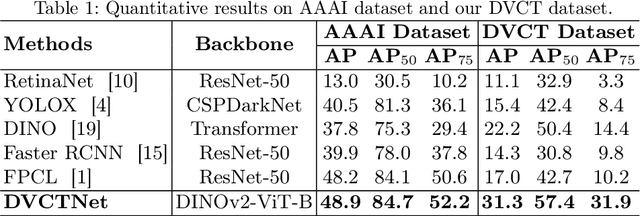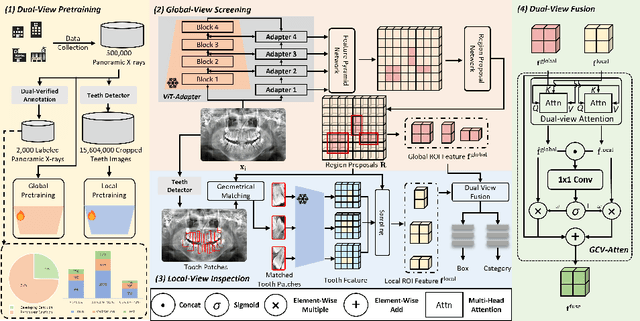Tong Yang
Michael Pokorny
MCPAgentBench: A Real-world Task Benchmark for Evaluating LLM Agent MCP Tool Use
Dec 31, 2025Abstract:Large Language Models (LLMs) are increasingly serving as autonomous agents, and their utilization of external tools via the Model Context Protocol (MCP) is considered a future trend. Current MCP evaluation sets suffer from issues such as reliance on external MCP services and a lack of difficulty awareness. To address these limitations, we propose MCPAgentBench, a benchmark based on real-world MCP definitions designed to evaluate the tool-use capabilities of agents. We construct a dataset containing authentic tasks and simulated MCP tools. The evaluation employs a dynamic sandbox environment that presents agents with candidate tool lists containing distractors, thereby testing their tool selection and discrimination abilities. Furthermore, we introduce comprehensive metrics to measure both task completion rates and execution efficiency. Experiments conducted on various latest mainstream Large Language Models reveal significant performance differences in handling complex, multi-step tool invocations. All code is open-source at Github.
NL2Repo-Bench: Towards Long-Horizon Repository Generation Evaluation of Coding Agents
Dec 14, 2025Abstract:Recent advances in coding agents suggest rapid progress toward autonomous software development, yet existing benchmarks fail to rigorously evaluate the long-horizon capabilities required to build complete software systems. Most prior evaluations focus on localized code generation, scaffolded completion, or short-term repair tasks, leaving open the question of whether agents can sustain coherent reasoning, planning, and execution over the extended horizons demanded by real-world repository construction. To address this gap, we present NL2Repo Bench, a benchmark explicitly designed to evaluate the long-horizon repository generation ability of coding agents. Given only a single natural-language requirements document and an empty workspace, agents must autonomously design the architecture, manage dependencies, implement multi-module logic, and produce a fully installable Python library. Our experiments across state-of-the-art open- and closed-source models reveal that long-horizon repository generation remains largely unsolved: even the strongest agents achieve below 40% average test pass rates and rarely complete an entire repository correctly. Detailed analysis uncovers fundamental long-horizon failure modes, including premature termination, loss of global coherence, fragile cross-file dependencies, and inadequate planning over hundreds of interaction steps. NL2Repo Bench establishes a rigorous, verifiable testbed for measuring sustained agentic competence and highlights long-horizon reasoning as a central bottleneck for the next generation of autonomous coding agents.
LPFQA: A Long-Tail Professional Forum-based Benchmark for LLM Evaluation
Nov 09, 2025Abstract:Large Language Models (LLMs) have made rapid progress in reasoning, question answering, and professional applications; however, their true capabilities remain difficult to evaluate using existing benchmarks. Current datasets often focus on simplified tasks or artificial scenarios, overlooking long-tail knowledge and the complexities of real-world applications. To bridge this gap, we propose LPFQA, a long-tail knowledge-based benchmark derived from authentic professional forums across 20 academic and industrial fields, covering 502 tasks grounded in practical expertise. LPFQA introduces four key innovations: fine-grained evaluation dimensions that target knowledge depth, reasoning, terminology comprehension, and contextual analysis; a hierarchical difficulty structure that ensures semantic clarity and unique answers; authentic professional scenario modeling with realistic user personas; and interdisciplinary knowledge integration across diverse domains. We evaluated 12 mainstream LLMs on LPFQA and observed significant performance disparities, especially in specialized reasoning tasks. LPFQA provides a robust, authentic, and discriminative benchmark for advancing LLM evaluation and guiding future model development.
MergeMoE: Efficient Compression of MoE Models via Expert Output Merging
Oct 16, 2025Abstract:The Mixture-of-Experts (MoE) technique has proven to be a promising solution to efficiently scale the model size, which has been widely applied in recent LLM advancements. However, the substantial memory overhead of MoE models has made their compression an important research direction. In this work, we provide a theoretical analysis of expert merging, a recently proposed technique for compressing MoE models. Rather than interpreting expert merging from the conventional perspective of parameter aggregation, we approach it from the perspective of merging experts' outputs. Our key insight is that the merging process can be interpreted as inserting additional matrices into the forward computation, which naturally leads to an optimization formulation. Building on this analysis, we introduce MergeMoE, a method that leverages mathematical optimization to construct the compression matrices. We evaluate MergeMoE on multiple MoE models and show that our algorithm consistently outperforms the baselines with the same compression ratios.
Fast Visuomotor Policy for Robotic Manipulation
Oct 14, 2025Abstract:We present a fast and effective policy framework for robotic manipulation, named Energy Policy, designed for high-frequency robotic tasks and resource-constrained systems. Unlike existing robotic policies, Energy Policy natively predicts multimodal actions in a single forward pass, enabling high-precision manipulation at high speed. The framework is built upon two core components. First, we adopt the energy score as the learning objective to facilitate multimodal action modeling. Second, we introduce an energy MLP to implement the proposed objective while keeping the architecture simple and efficient. We conduct comprehensive experiments in both simulated environments and real-world robotic tasks to evaluate the effectiveness of Energy Policy. The results show that Energy Policy matches or surpasses the performance of state-of-the-art manipulation methods while significantly reducing computational overhead. Notably, on the MimicGen benchmark, Energy Policy achieves superior performance with at a faster inference compared to existing approaches.
Inverse IFEval: Can LLMs Unlearn Stubborn Training Conventions to Follow Real Instructions?
Sep 04, 2025Abstract:Large Language Models (LLMs) achieve strong performance on diverse tasks but often exhibit cognitive inertia, struggling to follow instructions that conflict with the standardized patterns learned during supervised fine-tuning (SFT). To evaluate this limitation, we propose Inverse IFEval, a benchmark that measures models Counter-intuitive Abilitytheir capacity to override training-induced biases and comply with adversarial instructions. Inverse IFEval introduces eight types of such challenges, including Question Correction, Intentional Textual Flaws, Code without Comments, and Counterfactual Answering. Using a human-in-the-loop pipeline, we construct a dataset of 1012 high-quality Chinese and English questions across 23 domains, evaluated under an optimized LLM-as-a-Judge framework. Experiments on existing leading LLMs demonstrate the necessity of our proposed Inverse IFEval benchmark. Our findings emphasize that future alignment efforts should not only pursue fluency and factual correctness but also account for adaptability under unconventional contexts. We hope that Inverse IFEval serves as both a diagnostic tool and a foundation for developing methods that mitigate cognitive inertia, reduce overfitting to narrow patterns, and ultimately enhance the instruction-following reliability of LLMs in diverse and unpredictable real-world scenarios.
Adapting Foundation Model for Dental Caries Detection with Dual-View Co-Training
Aug 28, 2025



Abstract:Accurate dental caries detection from panoramic X-rays plays a pivotal role in preventing lesion progression. However, current detection methods often yield suboptimal accuracy due to subtle contrast variations and diverse lesion morphology of dental caries. In this work, inspired by the clinical workflow where dentists systematically combine whole-image screening with detailed tooth-level inspection, we present DVCTNet, a novel Dual-View Co-Training network for accurate dental caries detection. Our DVCTNet starts with employing automated tooth detection to establish two complementary views: a global view from panoramic X-ray images and a local view from cropped tooth images. We then pretrain two vision foundation models separately on the two views. The global-view foundation model serves as the detection backbone, generating region proposals and global features, while the local-view model extracts detailed features from corresponding cropped tooth patches matched by the region proposals. To effectively integrate information from both views, we introduce a Gated Cross-View Attention (GCV-Atten) module that dynamically fuses dual-view features, enhancing the detection pipeline by integrating the fused features back into the detection model for final caries detection. To rigorously evaluate our DVCTNet, we test it on a public dataset and further validate its performance on a newly curated, high-precision dental caries detection dataset, annotated using both intra-oral images and panoramic X-rays for double verification. Experimental results demonstrate DVCTNet's superior performance against existing state-of-the-art (SOTA) methods on both datasets, indicating the clinical applicability of our method. Our code and labeled dataset are available at https://github.com/ShanghaiTech-IMPACT/DVCTNet.
Multi-head Transformers Provably Learn Symbolic Multi-step Reasoning via Gradient Descent
Aug 11, 2025Abstract:Transformers have demonstrated remarkable capabilities in multi-step reasoning tasks. However, understandings of the underlying mechanisms by which they acquire these abilities through training remain limited, particularly from a theoretical standpoint. This work investigates how transformers learn to solve symbolic multi-step reasoning problems through chain-of-thought processes, focusing on path-finding in trees. We analyze two intertwined tasks: a backward reasoning task, where the model outputs a path from a goal node to the root, and a more complex forward reasoning task, where the model implements two-stage reasoning by first identifying the goal-to-root path and then reversing it to produce the root-to-goal path. Our theoretical analysis, grounded in the dynamics of gradient descent, shows that trained one-layer transformers can provably solve both tasks with generalization guarantees to unseen trees. In particular, our multi-phase training dynamics for forward reasoning elucidate how different attention heads learn to specialize and coordinate autonomously to solve the two subtasks in a single autoregressive path. These results provide a mechanistic explanation of how trained transformers can implement sequential algorithmic procedures. Moreover, they offer insights into the emergence of reasoning abilities, suggesting that when tasks are structured to take intermediate chain-of-thought steps, even shallow multi-head transformers can effectively solve problems that would otherwise require deeper architectures.
Fairy$\pm i$: the First 2-bit Complex LLM with All Parameters in $\{\pm1, \pm i\}$
Aug 07, 2025Abstract:Quantization-Aware Training (QAT) integrates quantization into the training loop, enabling LLMs to learn robust low-bit representations, and is widely recognized as one of the most promising research directions. All current QAT research focuses on minimizing quantization error on full-precision models, where the full-precision accuracy acts as an upper bound (accuracy ceiling). No existing method has even attempted to surpass this ceiling. To break this ceiling, we propose a new paradigm: raising the ceiling (full-precision model), and then still quantizing it efficiently into 2 bits. We propose Fairy$\pm i$, the first 2-bit quantization framework for complex-valued LLMs. Specifically, our method leverages the representational advantages of the complex domain to boost full-precision accuracy. We map weights to the fourth roots of unity $\{\pm1, \pm i\}$, forming a perfectly symmetric and information-theoretically optimal 2-bit representation. Importantly, each quantized weight has either a zero real or imaginary part, enabling multiplication-free inference using only additions and element swaps. Experimental results show that Fairy$\pm i$ outperforms the ceiling of existing 2-bit quantization approaches in terms of both PPL and downstream tasks, while maintaining strict storage and compute efficiency. This work opens a new direction for building highly accurate and practical LLMs under extremely low-bit constraints.
FAF: A Feature-Adaptive Framework for Few-Shot Time Series Forecasting
Jun 24, 2025Abstract:Multi-task and few-shot time series forecasting tasks are commonly encountered in scenarios such as the launch of new products in different cities. However, traditional time series forecasting methods suffer from insufficient historical data, which stems from a disregard for the generalized and specific features among different tasks. For the aforementioned challenges, we propose the Feature-Adaptive Time Series Forecasting Framework (FAF), which consists of three key components: the Generalized Knowledge Module (GKM), the Task-Specific Module (TSM), and the Rank Module (RM). During training phase, the GKM is updated through a meta-learning mechanism that enables the model to extract generalized features across related tasks. Meanwhile, the TSM is trained to capture diverse local dynamics through multiple functional regions, each of which learns specific features from individual tasks. During testing phase, the RM dynamically selects the most relevant functional region from the TSM based on input sequence features, which is then combined with the generalized knowledge learned by the GKM to generate accurate forecasts. This design enables FAF to achieve robust and personalized forecasting even with sparse historical observations We evaluate FAF on five diverse real-world datasets under few-shot time series forecasting settings. Experimental results demonstrate that FAF consistently outperforms baselines that include three categories of time series forecasting methods. In particular, FAF achieves a 41.81\% improvement over the best baseline, iTransformer, on the CO$_2$ emissions dataset.
 Add to Chrome
Add to Chrome Add to Firefox
Add to Firefox Add to Edge
Add to Edge